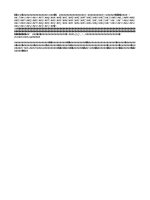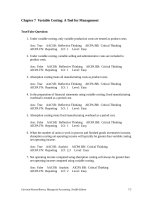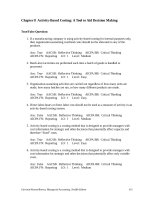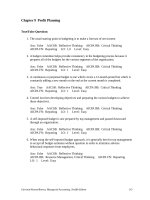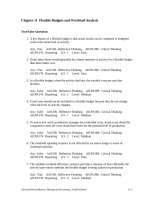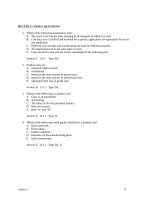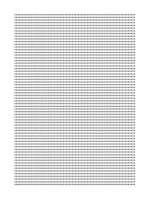Test bank managerial accounting by garrison 13e chapter 07
Bạn đang xem bản rút gọn của tài liệu. Xem và tải ngay bản đầy đủ của tài liệu tại đây (291.04 KB, 118 trang )
Chapter 7 Variable Costing: A Tool for Management
True/False Questions
1. Under variable costing, only variable production costs are treated as product costs.
Ans: True AACSB: Reflective Thinking AICPA BB: Critical Thinking
AICPA FN: Reporting LO: 1 Level: Easy
2. Under variable costing, variable selling and administrative costs are included in
product costs.
Ans: False AACSB: Reflective Thinking AICPA BB: Critical Thinking
AICPA FN: Reporting LO: 1 Level: Easy
3. Absorption costing treats all manufacturing costs as product costs.
Ans: True AACSB: Reflective Thinking AICPA BB: Critical Thinking
AICPA FN: Reporting LO: 1 Level: Easy
4. In the preparation of financial statements using variable costing, fixed manufacturing
overhead is treated as a period cost.
Ans: True AACSB: Reflective Thinking AICPA BB: Critical Thinking
AICPA FN: Reporting LO: 1 Level: Easy
5. Absorption costing treats fixed manufacturing overhead as a period cost.
Ans: False AACSB: Reflective Thinking AICPA BB: Critical Thinking
AICPA FN: Reporting LO: 1 Level: Easy
6. When the number of units in work in process and finished goods inventories increase,
absorption costing net operating income will typically be greater than variable costing
net operating income.
Ans: True AACSB: Analytic AICPA BB: Critical Thinking
AICPA FN: Reporting LO: 2,3 Level: Easy
7. Net operating income computed using absorption costing will always be greater than
net operating income computed using variable costing.
Ans: False AACSB: Analytic
AICPA FN: Reporting LO: 2
AICPA BB: Critical Thinking
Level: Easy
Garrison/Noreen/Brewer, Managerial Accounting, Twelfth Edition
7-5
Chapter 7 Variable Costing: A Tool for Management
8. When reconciling variable costing and absorption costing net operating income, fixed
manufacturing overhead costs released from inventory under absorption costing
should be added to variable costing net operating income to arrive at the absorption
costing net operating income.
Ans: False AACSB: Reflective Thinking AICPA BB: Critical Thinking
AICPA FN: Reporting LO: 3 Level: Medium
9. When production exceeds sales for the period, absorption costing net operating
income will exceed variable costing net operating income.
Ans: True AACSB: Analytic
AICPA FN: Reporting LO: 3
AICPA BB: Critical Thinking
Level: Medium
10. Under variable costing it may be possible to report a profit even if the company sells
less than the break-even volume of sales.
Ans: False AACSB: Analytic
AICPA FN: Reporting LO: 4
AICPA BB: Critical Thinking
Level: Medium
11. Absorption costing net operating income is closer to the net cash flow of a period than
is variable costing net operating income.
Ans: False AACSB: Analytic
AICPA FN: Reporting LO: 4
AICPA BB: Critical Thinking
Level: Medium
12. Variable costing is not permitted for income tax purposes, but it is widely accepted for
external financial reports.
Ans: False AACSB: Reflective Thinking AICPA BB: Critical Thinking
AICPA FN: Reporting LO: 4 Level: Medium
13. A basic concept of the contribution approach and variable costing is that fixed costs
are not important in an organization.
Ans: False AACSB: Reflective Thinking AICPA BB: Critical Thinking
AICPA FN: Reporting LO: 4 Level: Medium
14. Variable costing is better suited to cost-volume-profit calculations than absorption
costing.
Ans: True AACSB: Analytic
AICPA FN: Reporting LO: 4
7-6
AICPA BB: Critical Thinking
Level: Easy
Garrison/Noreen/Brewer, Managerial Accounting, Twelfth Edition
Chapter 7 Variable Costing: A Tool for Management
15. When lean production is introduced, the difference in net operating income computed
under the absorption and variable costing methods is reduced.
Ans: True AACSB: Analytic
AICPA FN: Reporting LO: 5
AICPA BB: Critical Thinking
Level: Easy
Multiple Choice Questions
16. How would the following costs be classified (product or period) under variable costing
at a retail clothing store?
A)
B)
C)
D)
Cost of purchasing clothing Sales commissions
Product
Product
Product
Period
Period
Product
Period
Period
Ans: B AACSB: Analytic AICPA BB: Critical Thinking
AICPA FN: Reporting LO: 1 Level: Medium
17. The principal difference between variable costing and absorption costing centers on:
A) whether variable manufacturing costs should be included as product costs.
B) whether fixed manufacturing costs should be included as product costs.
C) whether fixed manufacturing costs and fixed selling and administrative costs
should be included as product costs.
D) none of these.
Ans: B AACSB: Analytic AICPA BB: Critical Thinking
AICPA FN: Reporting LO: 1 Level: Easy
18. Which of the following costs at a manufacturing company would be treated as a
product cost under the variable costing method?
A) direct material cost
B) property taxes on the factory building
C) sales manager's salary
D) all of the above
Ans: A AACSB: Analytic AICPA BB: Critical Thinking
AICPA FN: Reporting LO: 1 Level: Medium
Garrison/Noreen/Brewer, Managerial Accounting, Twelfth Edition
7-7
Chapter 7 Variable Costing: A Tool for Management
19. Assuming that direct labor is a variable cost, the primary difference between the
absorption and variable costing is that:
A) variable costing treats only direct materials and direct labor as product cost
while absorption costing treats direct materials, direct labor, and the variable
portion of manufacturing overhead as product costs.
B) variable costing treats direct materials, direct labor, the variable portion of
manufacturing overhead, and an allocated portion of fixed manufacturing
overhead as product costs while absorption costing treats only direct materials,
direct labor, and the variable portion of manufacturing overhead as product
costs.
C) variable costing treats only direct materials, direct labor, the variable portion of
manufacturing overhead, and the variable portion of selling and administrative
expenses as product cost while absorption costing treats direct materials, direct
labor, the variable portion of manufacturing overhead, and an allocated portion
of fixed manufacturing overhead as product costs.
D) variable costing treats only direct materials, direct labor, and the variable portion
of manufacturing overhead as product costs while absorption costing treats
direct materials, direct labor, the variable portion of manufacturing overhead,
and an allocated portion of fixed manufacturing overhead as product costs.
Ans: D AACSB: Analytic AICPA BB: Critical Thinking
AICPA FN: Reporting LO: 1 Level: Medium
20. The costing method that treats all fixed costs as period costs is:
A) absorption costing.
B) job-order costing.
C) variable costing.
D) process costing.
Ans: C AACSB: Reflective Thinking AICPA BB: Critical Thinking
AICPA FN: Reporting LO: 1 Level: Easy
7-8
Garrison/Noreen/Brewer, Managerial Accounting, Twelfth Edition
Chapter 7 Variable Costing: A Tool for Management
21. In its first year of operations, Bronfren Corporation produced 800,000 sets and sold
780,000 sets of artificial tan lines. What would have happened to net operating income
in this first year under the following costing methods if Bronfren had produced 20,000
fewer sets? (Assume that Bronfren has both variable and fixed production costs.)
Variable costing Absorption costing
A)
Increase
Increase
B)
Decrease
Increase
C)
Decrease
Decrease
D)
No effect
Decrease
Ans: D AACSB: Analytic AICPA BB: Critical Thinking
AICPA FN: Reporting LO: 2 Level: Medium
22. When sales are constant, but the production level fluctuates, net operating income
determined by the variable costing method will:
A) fluctuate in direct proportion to changes in production.
B) remain constant.
C) fluctuate inversely with changes in production.
D) be greater than net operating income under absorption costing.
Ans: B AACSB: Analytic AICPA BB: Critical Thinking
AICPA FN: Reporting LO: 2 Level: Medium
23. Under the variable costing method, which of the following is always expensed in its
entirety in the period in which it is incurred?
A) fixed manufacturing overhead cost
B) fixed selling and administrative expense
C) variable selling and administrative expense
D) all of the above
Ans: D AACSB: Reflective Thinking AICPA BB: Critical Thinking
AICPA FN: Reporting LO: 2 Level: Hard
Garrison/Noreen/Brewer, Managerial Accounting, Twelfth Edition
7-9
Chapter 7 Variable Costing: A Tool for Management
24. Which of the following will usually be found on an income statement prepared using
the absorption costing method?
A)
B)
C)
D)
Contribution Margin Gross Margin
Yes
Yes
Yes
No
No
Yes
No
No
Ans: C AACSB: Reflective Thinking AICPA BB: Critical Thinking
AICPA FN: Reporting LO: 2 Level: Easy
25. Net operating income under variable and absorption costing will generally:
A) always be equal.
B) never be equal.
C) be equal only when production and sales are equal.
D) be equal only when production exceeds sales.
Ans: C AACSB: Analytic AICPA BB: Critical Thinking
AICPA FN: Reporting LO: 3 Level: Medium
26. When production exceeds sales, net operating income reported under variable costing
generally will be:
A) greater than net operating income reported under absorption costing.
B) less than net operating income reported under absorption costing
C) equal to net operating income reported under absorption costing.
D) higher or lower because no generalization can be made.
Ans: B AACSB: Analytic AICPA BB: Critical Thinking
AICPA FN: Reporting LO: 3 Level: Medium
7-10
Garrison/Noreen/Brewer, Managerial Accounting, Twelfth Edition
Chapter 7 Variable Costing: A Tool for Management
27. Net operating income under absorption costing may differ from net operating income
determined under variable costing. How is this difference calculated?
A) change in the quantity of units in inventory times the fixed manufacturing
overhead rate per unit.
B) number of units produced during the period times the fixed manufacturing
overhead rate per unit.
C) change in the quantity of units in inventory times the variable manufacturing
cost per unit.
D) number of units produced during the period times the variable manufacturing
cost per unit.
Ans: A AACSB: Analytic AICPA BB: Critical Thinking
AICPA FN: Reporting LO: 3 Level: Hard Source: CMA, adapted
28. When sales are constant, but the production level fluctuates, net operating income
determined by the absorption costing method will:
A) tend to fluctuate in the same direction as fluctuations in the level of production.
B) tend to remain constant.
C) tend to fluctuate inversely with fluctuations in the level of production.
D) none of these
Ans: A AACSB: Analytic AICPA BB: Critical Thinking
AICPA FN: Reporting LO: 4 Level: Medium
29. A reason why absorption costing income statements are sometimes difficult for the
manager to interpret is that:
A) they omit variable expenses entirely in computing net operating income.
B) they shift portions of fixed manufacturing overhead from period to period
according to changing levels of inventories.
C) they include all fixed manufacturing overhead on the income statement each
year as a period cost.
D) they ignore inventory levels in computing income charges.
Ans: B AACSB: Analytic AICPA BB: Critical Thinking
AICPA FN: Reporting LO: 4 Level: Medium
Garrison/Noreen/Brewer, Managerial Accounting, Twelfth Edition
7-11
Chapter 7 Variable Costing: A Tool for Management
30. Under the theory of constraints (TOC), which of the following is treated as a period
cost?
A)
B)
C)
D)
Direct labor Direct material
Yes
Yes
Yes
No
No
Yes
No
No
Ans: B AACSB: Reflective Thinking AICPA BB: Critical Thinking
AICPA FN: Reporting LO: 5 Level: Medium
31. Fleet Corporation produces a single product. The company manufactured 700 units
last year. The ending inventory consisted of 100 units. There was no beginning
inventory. Variable manufacturing costs were $6.00 per unit and fixed manufacturing
costs were $2.00 per unit. What would be the change in the dollar amount of ending
inventory if variable costing was used instead of absorption costing?
A) $800 decrease
B) $200 decrease
C) $0
D) $200 increase
Ans: B AACSB: Analytic AICPA BB: Critical Thinking
AICPA FN: Reporting LO: 1 Level: Easy Source: CMA, adapted
Solution:
Change in inventory × Fixed manufacturing costs per unit
= 100 × $2 = $200 decrease
7-12
Garrison/Noreen/Brewer, Managerial Accounting, Twelfth Edition
Chapter 7 Variable Costing: A Tool for Management
32. Shun Corporation manufactures and sells a hand held calculator. The following
information relates to Shun's operations for last year:
Unit product cost under variable costing.........................
Fixed manufacturing overhead cost for the year.............
Fixed selling and administrative cost for the year...........
Units (calculators) produced and sold.............................
$5.20 per unit
$260,000
$180,000
400,000
What is Shun's unit product cost under absorption costing for last year?
A) $4.10
B) $4.55
C) $5.85
D) $6.30
Ans: C AACSB: Analytic AICPA BB: Critical Thinking
AICPA FN: Reporting LO: 1 Level: Easy
Solution:
Unit fixed manufacturing overhead = Fixed manufacturing overhead ÷ Units produced
= $260,000 ÷ 400,000 units = $0.65 per unit
Unit product cost = $5.20 + $0.65 = $5.85
Garrison/Noreen/Brewer, Managerial Accounting, Twelfth Edition
7-13
Chapter 7 Variable Costing: A Tool for Management
33. A manufacturing company that produces a single product has provided the following
data concerning its most recent month of operations:
Units in beginning inventory.....................
Units produced...........................................
Units sold...................................................
Units in ending inventory...........................
0
7,100
7,000
100
Variable costs per unit:
Direct materials.......................................
Direct labor.............................................
Variable manufacturing overhead...........
Variable selling and administrative.........
$33
$53
$1
$7
Fixed costs:
Fixed manufacturing overhead............... $170,400
Fixed selling and administrative.............
$7,000
What is the unit product cost for the month under variable costing?
A) $118
B) $94
C) $111
D) $87
Ans: D AACSB: Analytic AICPA BB: Critical Thinking
AICPA FN: Reporting LO: 1 Level: Easy
Solution:
Unit product cost = Direct materials + Direct labor + Variable manufacturing overhead
= $33 + $53 + $1 = $87
7-14
Garrison/Noreen/Brewer, Managerial Accounting, Twelfth Edition
Chapter 7 Variable Costing: A Tool for Management
34. A manufacturing company that produces a single product has provided the following
data concerning its most recent month of operations:
Units in beginning inventory.....................
Units produced...........................................
Units sold...................................................
Units in ending inventory...........................
0
1,900
1,700
200
Variable costs per unit:
Direct materials.......................................
Direct labor.............................................
Variable manufacturing overhead...........
Variable selling and administrative.........
$33
$32
$2
$6
Fixed costs:
Fixed manufacturing overhead............... $72,200
Fixed selling and administrative............. $6,800
What is the unit product cost for the month under absorption costing?
A) $67
B) $105
C) $111
D) $73
Ans: B AACSB: Analytic AICPA BB: Critical Thinking
AICPA FN: Reporting LO: 1 Level: Easy
Solution:
Unit fixed manufacturing overhead = $72,200 ÷ 1,900 = $38
Unit product cost = Direct materials + Direct labor + Variable manufacturing overhead
cost + Fixed manufacturing overhead cost
= $33 + $32 + $2 + $38 = $105
Garrison/Noreen/Brewer, Managerial Accounting, Twelfth Edition
7-15
Chapter 7 Variable Costing: A Tool for Management
35. A manufacturing company that produces a single product has provided the following
data concerning its most recent month of operations:
Selling price...............................................
$79
Units in beginning inventory.....................
Units produced...........................................
Units sold...................................................
Units in ending inventory...........................
0
6,600
6,300
300
Variable costs per unit:
Direct materials.......................................
Direct labor.............................................
Variable manufacturing overhead...........
Variable selling and administrative.........
$14
$30
$4
$8
Fixed costs:
Fixed manufacturing overhead............... $46,200
Fixed selling and administrative............. $88,200
What is the total period cost for the month under the variable costing approach?
A) $138,600
B) $134,400
C) $46,200
D) $184,800
Ans: D AACSB: Analytic AICPA BB: Critical Thinking
AICPA FN: Reporting LO: 1 Level: Easy
Solution:
Total variable selling and administrative cost = $8 × 6,300 = $50,400
Period cost = Total variable selling and administrative cost + Fixed manufacturing
overhead + Fixed selling and administrative cost
= $50,400 + $46,200 + $88,200 = $184,800
7-16
Garrison/Noreen/Brewer, Managerial Accounting, Twelfth Edition
Chapter 7 Variable Costing: A Tool for Management
36. A manufacturing company that produces a single product has provided the following
data concerning its most recent month of operations:
Selling price...............................................
$97
Units in beginning inventory.....................
Units produced...........................................
Units sold...................................................
Units in ending inventory...........................
0
2,200
2,100
100
Variable costs per unit:
Direct materials.......................................
Direct labor.............................................
Variable manufacturing overhead...........
Variable selling and administrative.........
$32
$25
$2
$9
Fixed costs:
Fixed manufacturing overhead............... $8,800
Fixed selling and administrative............. $37,800
What is the total period cost for the month under the absorption costing approach?
A) $56,700
B) $65,500
C) $8,800
D) $37,800
Ans: A AACSB: Analytic AICPA BB: Critical Thinking
AICPA FN: Reporting LO: 1 Level: Easy
Solution:
Total variable selling and administrative cost = $9 × 2,100 = $18,900
Period cost = Variable selling and administrative cost + Fixed selling and
administrative cost = $18,900 + $37,800 = $56,700
Garrison/Noreen/Brewer, Managerial Accounting, Twelfth Edition
7-17
Chapter 7 Variable Costing: A Tool for Management
37. Mullee Corporation produces a single product and has the following cost structure:
Number of units produced each year.....................
7,000
Variable costs per unit:
Direct materials...................................................
$51
Direct labor.........................................................
$12
Variable manufacturing overhead.......................
$2
Variable selling and administrative expense.......
$5
Fixed costs per year:
Fixed manufacturing overhead........................... $441,000
Fixed selling and administrative expense........... $112,000
The unit product cost under absorption costing is:
A) $149
B) $65
C) $63
D) $128
Ans: D AACSB: Analytic AICPA BB: Critical Thinking
AICPA FN: Reporting LO: 1 Level: Easy
Solution:
Unit fixed manufacturing overhead = $441,000 ÷ 7,000 = $63
Unit product cost = $63 + $51 + $12 + $2 = $128
7-18
Garrison/Noreen/Brewer, Managerial Accounting, Twelfth Edition
Chapter 7 Variable Costing: A Tool for Management
38. Stoneberger Corporation produces a single product and has the following cost
structure:
Number of units produced each year.....................
4,000
Variable costs per unit:
Direct materials...................................................
$50
Direct labor.........................................................
$72
Variable manufacturing overhead.......................
$6
Variable selling and administrative expense.......
$3
Fixed costs per year:
Fixed manufacturing overhead........................... $296,000
Fixed selling and administrative expense........... $76,000
The unit product cost under variable costing is:
A) $128
B) $125
C) $202
D) $131
Ans: A AACSB: Analytic AICPA BB: Critical Thinking
AICPA FN: Reporting LO: 1 Level: Easy
Solution:
Unit product cost = $50 + $72 + $6 = $128
Garrison/Noreen/Brewer, Managerial Accounting, Twelfth Edition
7-19
Chapter 7 Variable Costing: A Tool for Management
39. Beamish Inc., which produces a single product, has provided the following data for its
most recent month of operations:
Number of units produced.....................................
Variable costs per unit:
Direct materials...................................................
Direct labor.........................................................
Variable manufacturing overhead.......................
Variable selling and administrative expense.......
Fixed costs:
Fixed manufacturing overhead...........................
Fixed selling and administrative expense...........
8,000
$37
$56
$4
$2
$312,000
$448,000
There were no beginning or ending inventories. The unit product cost under absorption
costing was:
A) $93
B) $97
C) $136
D) $194
Ans: C AACSB: Analytic AICPA BB: Critical Thinking
AICPA FN: Reporting LO: 1 Level: Easy
Solution:
Unit fixed manufacturing overhead = $312,000 ÷ 8,000 = $39
Unit product cost = $37 + $56 + $4 + $39 = $136
7-20
Garrison/Noreen/Brewer, Managerial Accounting, Twelfth Edition
Chapter 7 Variable Costing: A Tool for Management
40. Kray Inc., which produces a single product, has provided the following data for its
most recent month of operations:
Number of units produced...............................................
3,000
Variable costs per unit:
Direct materials............................................................
$91
Direct labor...................................................................
$13
Variable manufacturing overhead.................................
$7
Variable selling and administrative expense.................
$6
Fixed costs:
Fixed manufacturing overhead..................................... $237,000
Fixed selling and administrative expense..................... $165,000
There were no beginning or ending inventories. The unit product cost under variable
costing was:
A) $111
B) $190
C) $117
D) $110
Ans: A AACSB: Analytic AICPA BB: Critical Thinking
AICPA FN: Reporting LO: 1 Level: Easy
Solution:
Unit product cost = Direct materials + Direct labor + Variable manufacturing overhead
= $91 + $13 + $7 = $111
Garrison/Noreen/Brewer, Managerial Accounting, Twelfth Edition
7-21
Chapter 7 Variable Costing: A Tool for Management
41. The following data pertain to last year's operations at Clarkson, Incorporated, a
company that produces a single product:
Units in beginning inventory.....................
Units produced...........................................
Units sold...................................................
0
100,000
98,000
Selling price per unit..................................
$10.00
Variable costs per unit:
Direct materials.......................................
Direct labor.............................................
Variable manufacturing overhead...........
Variable selling and administrative.........
$1.50
$2.50
$1.00
$2.00
Fixed costs per year:
Fixed manufacturing overhead............... $200,000
Fixed selling and administrative............. $50,000
What was the absorption costing net operating income last year?
A) $44,000
B) $48,000
C) $50,000
D) $49,000
Ans: B AACSB: Analytic AICPA BB: Critical Thinking
AICPA FN: Reporting LO: 2 Level: Medium
Solution:
Unit fixed manufacturing overhead = $200,000 ÷ 100,000 = $2
Unit product cost = $1.50 + $2.50 + $1 + $2 = $7
Absorption costing income statement
Sales ($10 × 98,000)..............................................
Cost of goods sold ($7 × 98,000)...........................
Gross margin..........................................................
Selling and administrative expenses expenses:
Variable selling and administrative..................... $196,000
Fixed selling and administrative.........................
50,000
Net operating income.............................................
7-22
$980,000
686,000
294,000
246,000
$ 48,000
Garrison/Noreen/Brewer, Managerial Accounting, Twelfth Edition
Chapter 7 Variable Costing: A Tool for Management
42. A manufacturing company that produces a single product has provided the following
data concerning its most recent month of operations:
Selling price...............................................
$135
Units in beginning inventory.....................
Units produced...........................................
Units sold...................................................
Units in ending inventory...........................
0
6,400
6,200
200
Variable costs per unit:
Direct materials..........................................
Direct labor................................................
Variable manufacturing overhead..............
Variable selling and administrative............
$49
$38
$6
$11
Fixed costs:
Fixed manufacturing overhead.................. $108,800
Fixed selling and administrative................ $74,400
The total contribution margin for the month under the variable costing approach is:
A) $155,000
B) $260,400
C) $192,200
D) $83,400
Ans: C AACSB: Analytic AICPA BB: Critical Thinking
AICPA FN: Reporting LO: 2 Level: Easy
Solution:
Sales revenue ($135 × 6,200).................................
Variable cost:..........................................................
Direct materials ($49 × 6,200)............................
Direct labor ($38 × 6,200)..................................
Variable manufacturing overhead ($6 × 6,200). .
Variable selling and administrative ($11 ×
6,200)...............................................................
Contribution margin...............................................
Garrison/Noreen/Brewer, Managerial Accounting, Twelfth Edition
$837,000
$303,800
235,000
37,200
68,200
644,800
$192,200
7-23
Chapter 7 Variable Costing: A Tool for Management
43. A manufacturing company that produces a single product has provided the following
data concerning its most recent month of operations:
Selling price...............................................
$123
Units in beginning inventory.....................
Units produced...........................................
Units sold...................................................
Units in ending inventory...........................
0
1,000
900
100
Variable costs per unit:
Direct materials.......................................
Direct labor.............................................
Variable manufacturing overhead...........
Variable selling and administrative.........
$41
$26
$4
$6
Fixed costs:
Fixed manufacturing overhead............... $17,000
Fixed selling and administrative............. $11,700
What is the net operating income for the month under variable costing?
A) $12,700
B) $5,600
C) $1,700
D) $14,400
Ans: A AACSB: Analytic AICPA BB: Critical Thinking
AICPA FN: Reporting LO: 2 Level: Medium
Solution:
Sales ($123 × 900).................................................
Variable cost of goods sold ($71 × 900)................
Less variable selling and administrative ($6 × 900)
Contribution margin...............................................
Fixed cost:
Fixed manufacturing overhead...........................
Fixed selling and administrative.........................
Net operating income.............................................
7-24
$110,700
63,900
5,400
41,400
$17,000
11,700
28,700
$ 12,700
Garrison/Noreen/Brewer, Managerial Accounting, Twelfth Edition
Chapter 7 Variable Costing: A Tool for Management
44. Swifton Company produces a single product. Last year, the company had net operating
income of $40,000 using variable costing. Beginning and ending inventories were
22,000 and 27,000 units, respectively. If the fixed manufacturing overhead cost was
$3.00 per unit, what was the income using absorption costing?
A) $15,000
B) $25,000
C) $40,000
D) $55,000
Ans: D AACSB: Analytic AICPA BB: Critical Thinking
AICPA FN: Reporting LO: 3 Level: Medium
Solution:
Difference between absorption costing net income and variable costing net
income = Change in inventory in units × Unit fixed manufacturing overhead
= (27,000 − 22,000) × $3 = 5,000 × $3 = $15,000
Net income under absorption costing = $40,000 + $15,000 = $55,000
45. Blake Company produces a single product. Last year, Blake's net operating income
under absorption costing was $3,600 lower than under variable costing. The company
sold 10,000 units during the year, and its variable costs were $9 per unit, of which $1
was variable selling expense. If production cost was $11 per unit under absorption
costing, then how many units did the company produce during the year?
A) 8,200 units
B) 8,800 units
C) 11,200 units
D) 11,800 units
Ans: B AACSB: Analytic AICPA BB: Critical Thinking
AICPA FN: Reporting LO: 3 Level: Hard
Solution:
Direct material + Direct labor + Variable manufacturing overhead
= Variable unit product cost = $9 – $1 = $8
Unit fixed manufacturing overhead = $11 – $8 = $3
Difference in net income between methods ÷ Unit fixed manufacturing overhead =
($3,600) ÷ $3 per unit = (1,200) units
Units produced = Units sold + Change in inventory = 10,000 + (1,200) = 8,800
Garrison/Noreen/Brewer, Managerial Accounting, Twelfth Edition
7-25
Chapter 7 Variable Costing: A Tool for Management
46. Pungent Corporation manufactures and sells a spice rack. Shown below are the actual
operating results for the first two years of operations:
Units (spice racks) produced..................................
Units (spice racks) sold..........................................
Absorption costing net operating income..............
Variable costing net operating income...................
Year 1
Year 2
40,000 40,000
37,000 41,000
$44,000 $52,000
$38,000
???
Pungent's cost structure and selling price were the same for both years. What is
Pungent's variable costing net operating income for Year 2?
A) $48,000
B) $50,000
C) $54,000
D) $56,000
Ans: C AACSB: Analytic AICPA BB: Critical Thinking
AICPA FN: Reporting LO: 3 Level: Hard
Solution:
Unit fixed manufacturing overhead = Difference in net income ÷ Change in inventory
= ($44,000 – $38,000) ÷ (40,000 – 37,000) = $6,000 ÷ 3,000 = $2
Variable costing net operating income = Absorption costing net income − Difference
in net operating income
= $52,000 − [(40,000 − 41,000) × $2)]
= $52,000 − ($2,000) = $54,000
7-26
Garrison/Noreen/Brewer, Managerial Accounting, Twelfth Edition
Chapter 7 Variable Costing: A Tool for Management
47. Sipho Corporation manufactures a variety of products. Last year, the company's
variable costing net operating income was $90,900. Fixed manufacturing overhead
costs released from inventory under absorption costing amounted to $21,900. What
was the absorption costing net operating income last year?
A) $69,000
B) $90,900
C) $21,900
D) $112,800
Ans: A AACSB: Analytic AICPA BB: Critical Thinking
AICPA FN: Reporting LO: 3 Level: Easy
Solution:
Absorption costing net income = Variable costing net income – fixed manufacturing
overhead costs released from inventory
= $90,900 – $21,900 = $69,000
48. Last year, Kirsten Corporation's variable costing net operating income was $63,400.
Fixed manufacturing overhead costs released from inventory under absorption costing
amounted to $10,700. What was the absorption costing net operating income last year?
A) $10,700
B) $74,100
C) $63,400
D) $52,700
Ans: D AACSB: Analytic AICPA BB: Critical Thinking
AICPA FN: Reporting LO: 3 Level: Easy
Solution:
Absorption costing net income = Variable costing net income – fixed manufacturing
overhead costs released from inventory
= $63,400 – $10,700 = $52,700
Garrison/Noreen/Brewer, Managerial Accounting, Twelfth Edition
7-27
Chapter 7 Variable Costing: A Tool for Management
49. Bellue Inc. manufactures a variety of products. Variable costing net operating income
was $96,300 last year and ending inventory decreased by 2,600 units. Fixed
manufacturing overhead cost was $1 per unit. What was the absorption costing net
operating income last year?
A) $2,600
B) $93,700
C) $96,300
D) $98,900
Ans: B AACSB: Analytic AICPA BB: Critical Thinking
AICPA FN: Reporting LO: 3 Level: Medium
Solution:
Absorption costing net income = Variable costing net income − fixed manufacturing
overhead costs released from inventory
= $96,300 − [2,600 × $1] = $96,300 − $2,600 = $93,700
50. Last year, Tinklenberg Corporation's variable costing net operating income was
$52,400 and its ending inventory decreased by 1,400 units. Fixed manufacturing
overhead cost was $8 per unit. What was the absorption costing net operating income
last year?
A) $41,200
B) $11,200
C) $63,600
D) $52,400
Ans: A AACSB: Analytic AICPA BB: Critical Thinking
AICPA FN: Reporting LO: 3 Level: Medium
Solution:
Absorption costing net income = Variable costing net income − fixed manufacturing
overhead costs released from inventory
= $52,400 − [1,400 × $8] = $52,400 − $11,200 = $41,200
7-28
Garrison/Noreen/Brewer, Managerial Accounting, Twelfth Edition
Chapter 7 Variable Costing: A Tool for Management
Use the following to answer questions 51-53:
Hurlex Company produces a single product. Last year, Hurlex manufactured 15,000 units and
sold 12,000 units. Production costs for the year were as follows:
Direct materials......................................................
Direct labor............................................................
Variable manufacturing overhead..........................
Fixed manufacturing overhead..............................
$150,000
$180,000
$135,000
$210,000
Sales totaled $840,000 for the year, variable selling expenses totaled $60,000, and fixed
selling and administrative expenses totaled $180,000. There were no units in the beginning
inventory. Assume that direct labor is a variable cost.
51. The contribution margin per unit would be:
A) $25
B) $39
C) $34
D) $35
Ans: C AACSB: Analytic AICPA BB: Critical Thinking
AICPA FN: Reporting LO: 2 Level: Hard
Solution:
Unit selling price ($840,000 ÷ 12,000)..................
Less direct materials ($150,000 ÷ 15,000).............
Less direct labor ($180,000 ÷ 15,000)...................
Less variable manufacturing overhead ($135,000
÷ 15,000)............................................................
Less variable selling and administrative ($60,000
÷ 12,000)............................................................
Contribution margin...............................................
Garrison/Noreen/Brewer, Managerial Accounting, Twelfth Edition
$70
$10
12
9
5
36
$34
7-29
